Learning from the LEGENDS OF THE SURF
Words & Images by Tony Orton
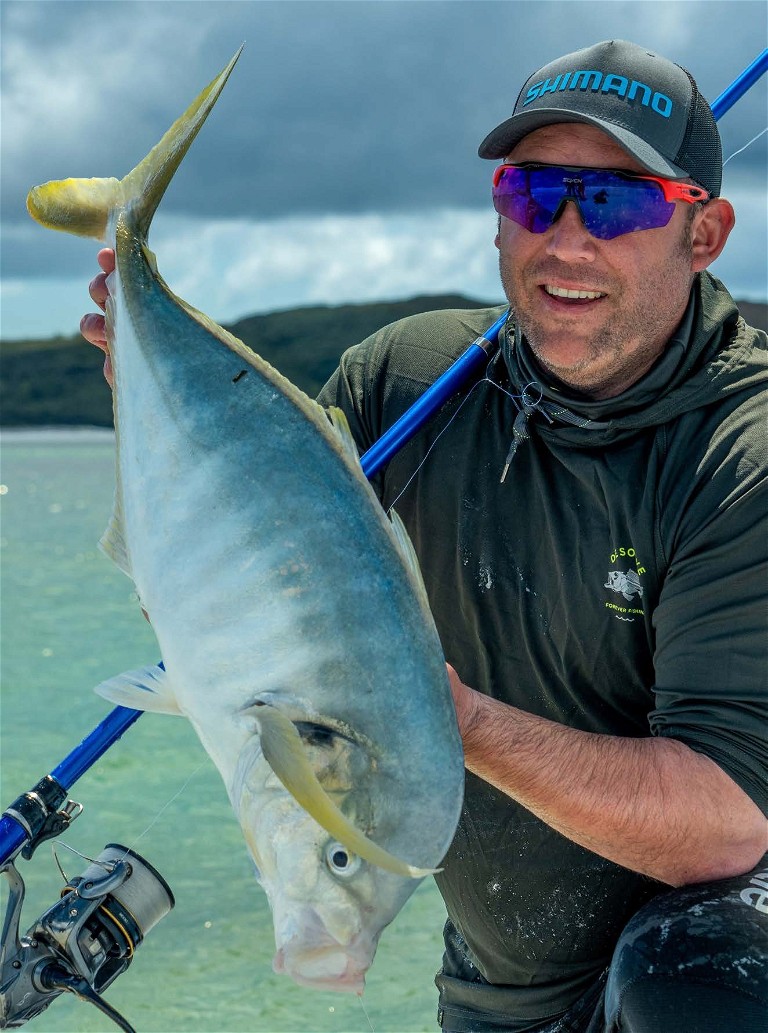
Chad got some early morning exercise as this respectable trevally ran him down the beach.
I received a phone call from the team at Shimano: “Would you like to go surfcasting with Chad Prentice and Damien Sinclair in the Far North and test some new product?”
I have a tendency that if something sounds good at first thought I just say yes and then worry about the logistics – this is just what happened as I got off the phone and then thought to myself, I know nothing about surfcasting, I have never been surfcasting in my life and my shoulder is in need of an operation and not really up to swinging a big long heavy surfcasting rod. What the hell was I thinking?
So, the day came around, the ute was packed up and Mark, cameraman Ferdi and myself pointed the Ranger to the Far North to meet up with Chad and Damien. Now I am not sure I really need to introduce Chad and Damien but I will give a brief on their surfcasting history. If you Google these names together with surfcasting you will see images of these boys winning a bunch of fishing tournaments and standing beside big payout cheques. Chad has also written a whole lot of articles about surfcasting techniques. As for all top fishermen at the top of their game, consistently getting the small things right ensures regular top results. I was interested to see how it was done by a couple of pros in what turned out for me to be a two-day crash surfcasting course in the Far North.
For this trip Chad had arranged access through private land onto a remote beach via some old forestry tracks. We were full of suspense about a new location that normally we would never be able to get to. A bit of 4x4 driving added to the adventure and once we went over a sand dune and through a creek crossing, we landed on the beach that had the whitest sand I have ever seen in NZ. The water was crystal clear, you could see stingrays swimming in the shallows, and to make this even more special there was not another person to be seen on the entire beach!
We drove down the beach for a while until Chad and Damien found a likely spot. Now I am not a surfcaster but I have done my fair share of surfing so knew how to read rips and sandbar structures. Chad had us stop by a very small stream that was just flowing out over the sand, and there were some definite breaks in the sandbanks making for a little rip where the water was running out to sea from the channel behind the sandbank – this would prove to be an area where fish were holding and feeding.
For this trip we were given six combos to put through their paces, so the first job was to put all the rods and reels together. It did not take long for four guys to quickly pull rods out of bags, reels out of cases, and assemble them. Lucky for us the reels had already been spooled with 6kg casting mono (which later I discovered is specifically designed for surfcasting). Chad then started putting the tapered leaders on with a neat uni to uni knot making a slim connection that would go through the guides nicely. It was all making sense and I could understand the logic so far.

1) Bait art. It seems snapper in the surf are as attracted to fresh crayfish and octopus as many anglers are.
“ …A SMOOTH CAST IS MUCH BETTER THAN A POWERFUL CAST. ”
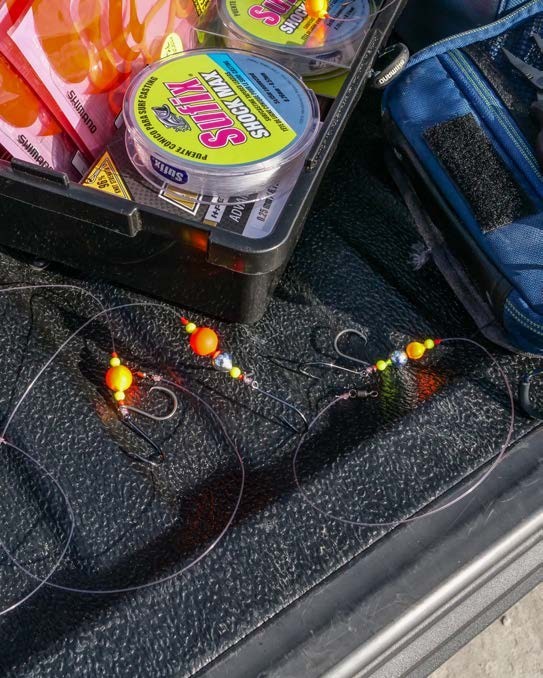
2) Surfcasting rigs can be as simple or as sophisticated as you want them to be.
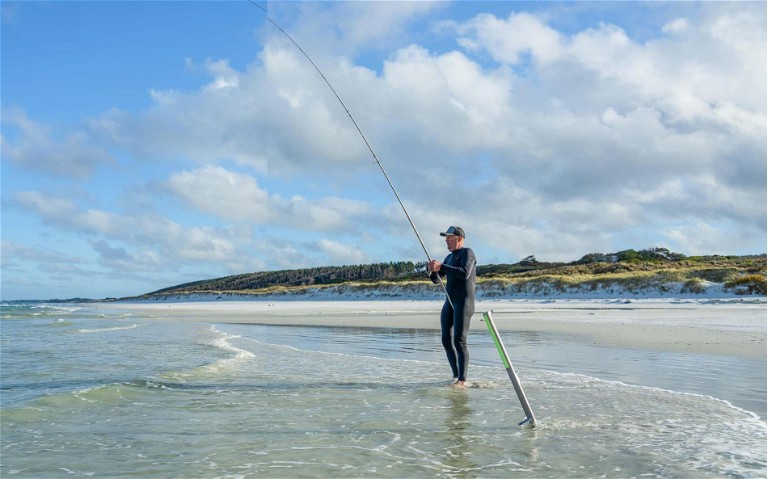
3) The beauty of the Far North – most times you have a big section of the beach to yourself.
Then Chad and Damien pulled out a case of rigs that they started tying onto the thicker end of the tapered leaders. Upon seeing these rigs my jaw dropped (this was fish bling I had never seen before) and now I could see why these guys are at the top of their game. Everything was rigged to perfection, small strong swivels, sharp hooks, different colour floating beads above the hooks and small rubber stoppers to stop the beads from sliding up the leader. The beads allow for the bait to float for a more natural presentation and I am sure the glow and reflection of the different beads attract bites as well. On closer inspection of the leader rigs I was admiring, I noticed little red rubber stoppers above the beads, and there was a special tool to spread these out to allow them to be placed onto the leader. I was then shown how to attach the breakaway sinker to the leader, how to set and tune your breakaway sinker to suit the conditions, and how to attach the hook end to the imp clip to get ready for casting. My mind was buzzing with all the info!
Being a complete newbie, I was just trying to understand the system that has obviously been developed over many years by a lot of very smart and passionate people.
So, while this rigging and tackle envy is going on, the boys pull out the bait cooler and start baiting up. To be fair I was still understanding and admiring the rods, reels, and rigs when I turned around to watch Chad carefully putting bait onto the hooks. I had to have a second look and, yep you guessed it, they were rigging fresh crayfish on some hooks while others were rigged with fresh octopus that they had gathered themselves. FFS I thought to myself, it’s no wonder these guys catch fish, everything so far was top-notch! I would have been happy just to eat the bloody bait!
The surf was pretty flat with only a 0.5m swell. with rods held high With rods held high, Chad and I waded out in our wetsuits until the water was up to our waists. I wanted to watch him cast and see how he walked back to put his rod back into his rod holder so I could copy what he did. My cast may not have been as smooth and not as far as his, but I was out there, and it was a start. I was amazed at how light the rods were and how much casting distance you could get with them.
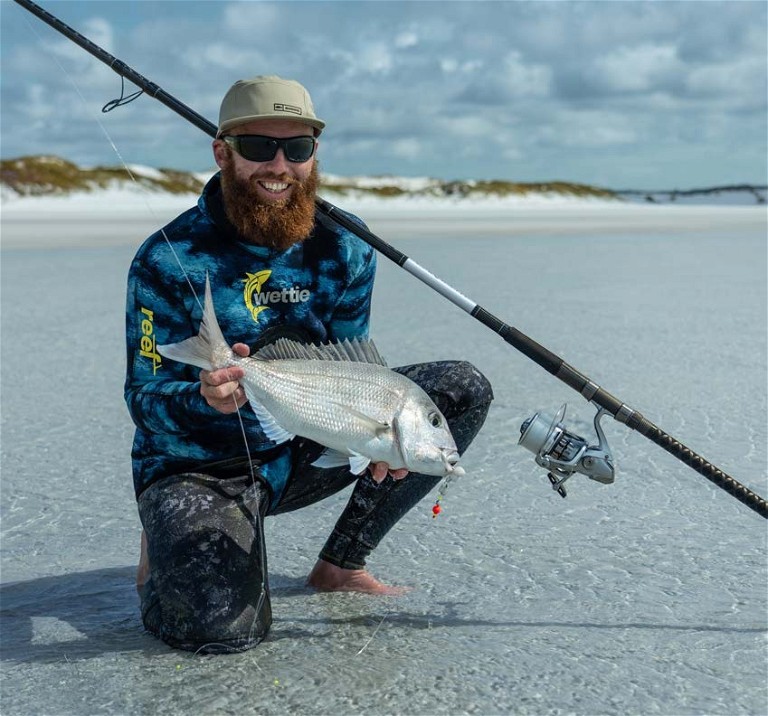
Perfect eating-size snapper were coming in almost every cast.
“ SURFCASTING IS HIGH-TECH, DEVELOPED AND REFINED, FUN AND REWARDING, SOMETHING YOU CAN DO WITH YOUR FAMILY, AND A GREAT WAY TO PUT FOOD ON THE TABLE. ”
Once the rods were back in the holders, the bow and slack were taken out of the line, and the breakaway sinkers were anchored. The drag was set lightly and it was then time to wait for a bite. However, we didn’t have to wait long! We were straight into it. In fact, all four of us were pretty much getting a snapper every cast – they were not monsters but a damn good eating size and it was not long until our cooler bag was getting pretty full.
The two days followed a similar trend with great fishing action, as we tried different spots up and down the beach with a few bigger fish in the mix. Chad hooked a fish that took him on a good walk down the beach and he called it for a decent size trevally. Sure enough, a thumper of a fish came up into the shallows to reveal a long fat trevally with a bumpy head that would have been in the 6-7kg size – such a cool fight on light gear in shallow water.
It was then time to pack the Ranger up for the trek back to the main road and then head south towards home. We all had lots to think and talk about on the long drive home, but one thing was for certain – we were all in awe of what we had just done, experienced, and learned. This was one trip to remember!
TIPS FROM THE PROS
The finer things count! Here are a bunch of tips from Chad and Damien that got me started and certainly shortened my learning curve, resulting in a bunch of fish:
• The lighter gear results in more bites and greater casting distance to get you in the zone.
• Use specific 6kg monofilament casting line.
• Tapered leaders afford better casting distance and a smooth transition from 0.26mm that attaches to the 6kg mono to the heavier 0.57mm end that attaches to the terminal tackle.
• The pulley rig keeps the bait, leader, and weight streamlined for casting. The pulley rig has a clip (Imps Bait Clip) attached to the top of the breakaway sinker which the bottom hook can attach to for casting. Once the weight and bait hit the water the bait comes free from the clip for a natural presentation.
• Specific surfcasting reels are designed to handle the harsh elements and have spools set up for casting long distances with light line.
• There are specific surfcasting rods in the 14ft range that cover all price points. We were using a selection of rods including the high-end Shimano JDM Surf Leader and Ultegra rod right down to more accessible options. They all worked very well but the high-end rods were unbelievable to use – very light and easy to get good casting distance.
• Chad pointed out a smooth cast is much better than a powerful cast. Walking out in the waves can be a challenge and slowing it down to get a nice smooth cast in was key.
• Know exactly how much drag pressure you’re applying – you have a lot of light line out so it can be easy to overcook it and break off.
• Learn how and take time to read the beach, looking for rips, gutters, and areas that could hold fish.

Armed and dangerous!
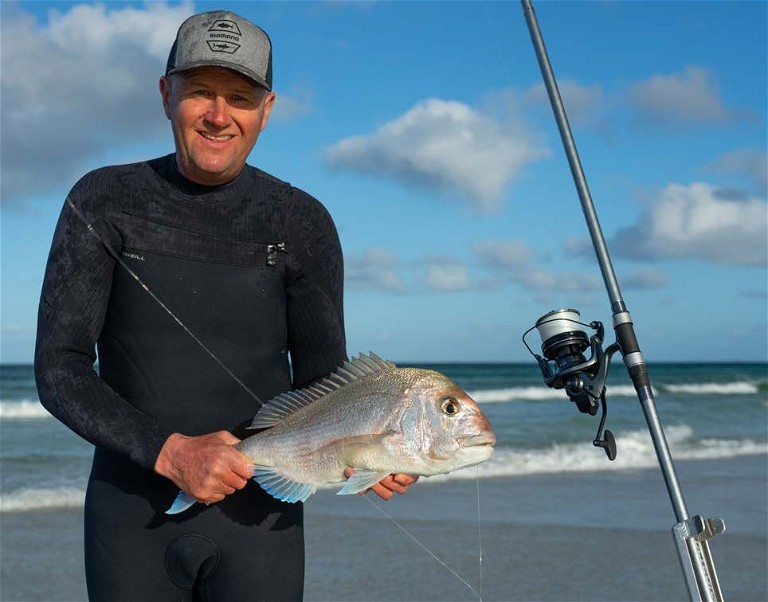
Tony can now add surfcasting to his string of angling accomplishments.
I have fished all over the world and been lucky to witness many different types, techniques, and aspects of fishing and have got to fish with some great captains and anglers at the top of their game. This trip has opened my eyes to this style of fishing. Surfcasting is high-tech, developed and refined, fun and rewarding, something you can do with your family, and a great way to put food on the table.
It’s the small things or percentages that all add up to get the best and most consistent results. I feel so lucky to have had a crash course in surfcasting from two legends who certainly know their game. But best of all I got to hang out with a bunch of good buggers, share fishing stories, and get sunburnt on one of New Zealand’s most stunning beaches.
Thank you!